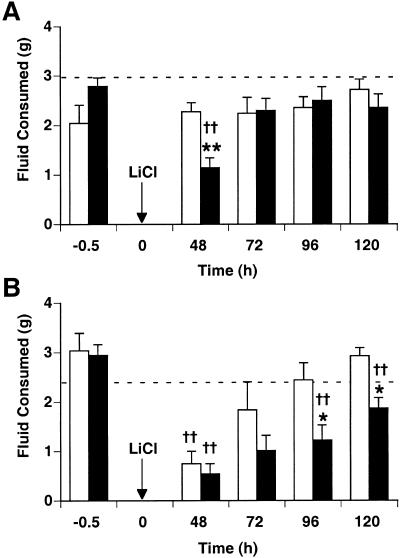Figure 1.
Conditioned taste aversion at low and high doses of LiCl. Taste solutions of 5% sucrose and 75 mM NaCl were offered for 30 min and mice were injected with either malaise-inducing LiCl or NaCl as control (n = 6–10/group). Beginning 48 h after pairing, CTA was tested in single bottle, 30 min intake tests at 24 h intervals. Arrows indicate time at which LiCl was injected (0.15 M, 20 mL/kg or 40 mL/kg, i.p.). Dashed lines represent average intakes of NaCl-injected controls (knockout pooled with wild type). (A) CTA after sucrose and saline paired with 20 mL/kg LiCl. Spinophilin knockout mice (white bars) did not express CTA at all; wild-type mice (black bars) express CTA 48 h postinjection, which is rapidly extinguished after just 24 h. (B) CTA after sucrose and saline paired with 40 mL/kg LiCl. Both spinophilin knockouts and wild types express CTA at 48 h. CTA was extinguished rapidly in knockout mice, returning to control levels 24 h later. Wild-type CTA extinguished more slowly, significantly differing from knockouts at 96 h and 120 h. (*) P < 0.05 vs. wild type; (**) P < 0.01 vs. wild type; (†) P < 0.05 vs. NaCl-injected controls; (††) P < 0.01 vs. NaCl-injected controls.

